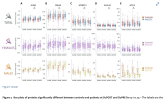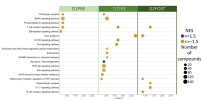TiredMathematician
Established Member
Highlights
• Plasma profiling of 7,288 proteins during post-exertional malaise in ME/CFS.
• ME/CFS participants show sustained immune, metabolic, and neuromuscular dysregulation during post-exercise recovery.
• Exertion disrupts T and B cell signaling, IL-17 pathways, and mitochondrial metabolism.
• Protein signatures correlate with symptom severity and impaired exercise performance in ME/CFS subjects.
• Sex-stratified analysis reveals distinct molecular responses, underscoring the importance of sex in ME/CFS pathophysiology.
Abstract
The overarching symptom of myalgic encephalomyelitis/chronic fatigue syndrome (ME/CFS) is post-exertional malaise (PEM), an exacerbation of symptoms following physical or mental exertion. To investigate the molecular underpinnings of PEM, we performed longitudinal plasma proteomics using the Somascan® 7K aptamer-based assay to monitor 6,361 unique plasma proteins in 132 individuals (96 females and 36 males) subjected to two maximal cardiopulmonary exercise tests separated by a 24-hour recovery period. The cohort included 79 ME/CFS cases compared to 53 age- and BMI-matched sedentary controls, allowing us to distinguish disease-specific molecular alterations from those due to physical deconditioning. Longitudinal profiling revealed widespread proteomic changes following exertion, with the most pronounced alterations observed in ME/CFS participants during the recovery phase, coinciding with the onset of PEM. Compared to controls, ME/CFS subjects showed persistent dysregulation of immune, metabolic, and neuromuscular pathways. Key findings included suppression of T and B cell signaling, downregulation of IL-17 and cell-cell communication pathways, and upregulation of glycolysis/gluconeogenesis, suggestive of mitochondrial stress and impaired immune recovery from exercise. Proteomic associations with physiological performance (VO2max, anaerobic threshold) revealed disruptions between protein abundance and exercise capacity in ME/CFS versus controls. Correlations with symptom severity linked changes in immune-related proteins and ME/CFS symptoms including muscle pain, recurrent sore throat, and lymph node tenderness. Sex-stratified analyses revealed distinct molecular responses between females and males, emphasizing the importance of considering sex as a biological variable in ME/CFS research. Finally, our analysis of sedentary controls contributes new data of molecular responses to acute exertion in a predominantly female sedentary cohort, a population historically underrepresented in exercise physiology studies. Together, these findings underscore the value of dynamic, proteomic profiling over time for characterizing maladaptive responses to exertion in ME/CFS and provide a foundation for deeper mechanistic investigation into PEM.
Graphical Abstract

https://www.mcponline.org/article/S1535-9476(25)00566-3/fulltext (Open Access)
• Plasma profiling of 7,288 proteins during post-exertional malaise in ME/CFS.
• ME/CFS participants show sustained immune, metabolic, and neuromuscular dysregulation during post-exercise recovery.
• Exertion disrupts T and B cell signaling, IL-17 pathways, and mitochondrial metabolism.
• Protein signatures correlate with symptom severity and impaired exercise performance in ME/CFS subjects.
• Sex-stratified analysis reveals distinct molecular responses, underscoring the importance of sex in ME/CFS pathophysiology.
Abstract
The overarching symptom of myalgic encephalomyelitis/chronic fatigue syndrome (ME/CFS) is post-exertional malaise (PEM), an exacerbation of symptoms following physical or mental exertion. To investigate the molecular underpinnings of PEM, we performed longitudinal plasma proteomics using the Somascan® 7K aptamer-based assay to monitor 6,361 unique plasma proteins in 132 individuals (96 females and 36 males) subjected to two maximal cardiopulmonary exercise tests separated by a 24-hour recovery period. The cohort included 79 ME/CFS cases compared to 53 age- and BMI-matched sedentary controls, allowing us to distinguish disease-specific molecular alterations from those due to physical deconditioning. Longitudinal profiling revealed widespread proteomic changes following exertion, with the most pronounced alterations observed in ME/CFS participants during the recovery phase, coinciding with the onset of PEM. Compared to controls, ME/CFS subjects showed persistent dysregulation of immune, metabolic, and neuromuscular pathways. Key findings included suppression of T and B cell signaling, downregulation of IL-17 and cell-cell communication pathways, and upregulation of glycolysis/gluconeogenesis, suggestive of mitochondrial stress and impaired immune recovery from exercise. Proteomic associations with physiological performance (VO2max, anaerobic threshold) revealed disruptions between protein abundance and exercise capacity in ME/CFS versus controls. Correlations with symptom severity linked changes in immune-related proteins and ME/CFS symptoms including muscle pain, recurrent sore throat, and lymph node tenderness. Sex-stratified analyses revealed distinct molecular responses between females and males, emphasizing the importance of considering sex as a biological variable in ME/CFS research. Finally, our analysis of sedentary controls contributes new data of molecular responses to acute exertion in a predominantly female sedentary cohort, a population historically underrepresented in exercise physiology studies. Together, these findings underscore the value of dynamic, proteomic profiling over time for characterizing maladaptive responses to exertion in ME/CFS and provide a foundation for deeper mechanistic investigation into PEM.
Graphical Abstract

https://www.mcponline.org/article/S1535-9476(25)00566-3/fulltext (Open Access)





